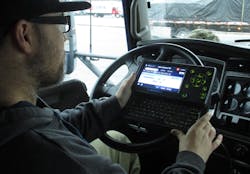FMCSA addresses ELD self-certification, transition questions
LITTLE ROCK. Might the Federal Motor Carrier Safety Administration delay the implementation of ELDs? How can ELD makers self-certify when FMCSA still hasn’t finalized a key feature of the system? How will FMCSA verify that ELDs are compliant? Will truck drivers just find new ways to get around HOS limits after ELDs are required?
With the initial deadline just over a year away, truck fleets still have plenty of questions about electronic logging devices and FMCSA’s mandate. And while “sympathetic” might not be the word that truckers would use, they certainly should understand why the folks on the other side of the roadside inspection window have lots of questions, too.
So it makes sense that FMCSA’s top management would bring their ongoing education campaign here to the annual gathering of trucking regulatory enforcement agencies. Indeed, the Commercial Vehicle Safety Alliance (CVSA) devoted a good portion of the conference’s first morning to ELDs, including Q&A periods that had attendees standing in line for a turn at the convention floor microphones.
The questions from roadside enforcement officers, along with some vendors and carriers, were generally focused on the transition, on the ELD self-certification process, and on some potential “gray areas” that could be troublesome in the field.
Q: With only a handful of currently vendors on the list of certified ELDs, and given how much time it takes for a large carrier to make a purchasing decision, install equipment, and train drivers and driver managers, might FMCSA delay the implementation deadline?
“We expect that we’re going to get more vendors on that list and that won’t be a problem,” said Bill Quade, FMCSA associate administrator for enforcement and program delivery. “If there’s a market out there for 8 million units, I believe the manufacturers are going to produce 8 million units. A year and three months [until the Dec. 18 implementation deadline] is a long time. This is why we gave everybody two years [after the rule was published]. FMCSA has no intention of moving the date."
Q: Since FMCSA hasn’t completed its part of the Web Services feature, how can vendors self-certify that their devices meet all of the test-case requirements of the ELD rule?
While it’s true that FMCSA hasn’t completed the system to allow roadside officers to download log data, ELD vendors just need to know that their devices are capable of transmitting the specified data when the time comes.
“If that output file can be generated, it will work in our Web Services; that’s how we’re designing it,” Quade said. “Essentially, we can implement the ELD rule without Web Services. If we have not delivered Web Services and eRODs before Dec. 18, the rule will go ahead and the roadside officer will use one of the other methods, either the printing or display requirement. Our delivery of Web Services does not stand in the way of certifying a device as being compliant.”
Speaking afterword, Fred Fakkema, v.p. of compliance for Zonar, explained to Fleet Owner that the Web Services delay was challenging for vendors whose ELDs will be incorporated into more complex fleet management telematics solutions—so Zonar is taking a wait and see approach to self-certification until the ELD actually could be tested with FMCSA’s Web Services. He also said Zonar hadn’t interpreted the self-certification requirement in the way Quade had, given the test case requirements. Still, he encouraged carriers to do their research when selecting a vendor and questioned self-certification and marketing an ELD before the full set of test cases could be completed.
Quade, however, said the self-certification requirements had not changed with the delay in Web Services, and that some vendors likely were being cautious in their interpretation.
Regardless, FMCSA fully expects to have Web Services enabled several months in advance of the deadline to allow time for testing and training.
Quade likened the self-certification process to that used by the auto industry, where manufacturers do their own testing and the government issues recalls if problems are discovered later, and so FMCSA will not be conducting regular audits of vendors.
“As a motor carrier, I would be doing a lot of homework on vendors and making sure that the vendor can demonstrate that they are able to produce,” Quade said. “We do not have the resources to do testing on all of the devices we are expecting to get. We will investigate them if there are indications of problems, and we will address them.”
Q: Does a manufacturer have to notify customers when an ELD is being audited?
FMCSA does not have any such requirement.
Q: What happens to a carrier when the ELD the fleet is using is decertified?
If discovered at roadside, the carrier will be cited for operating a non-compliant device—but that’s a one-time only notice. If caught again, the truck will be placed out of service. Carriers have an eight-day window from the time of the initial notice to install compliant ELDs.
But eight days isn’t much time to select, buy and install a new ELD, especially for a large fleet. The regulations, however, do contain provisions that allow for waivers, and FMCSA would take such circumstances into consideration, Quade noted.
Q: What is FMCSA doing to prevent abuse of the “personal conveyance” allowance under HOS?
FMCSA is looking into updating the guidance on personal conveyance, but the agency is limited in how specific the guidance can be without imposing limits that would otherwise require a formal rulemaking, such as setting the number of miles allowed to be logged.
“We do recognize the need to make our guidance a little bit more robust. Frankly, there are times when personal conveyance is a really, really good thing for people to use,” Quade said. “But we don’t want people using personal conveyance to go 150 miles toward their next pick up. Like a lot of this, we have to find some middle ground that allows for flexibility for drivers while at the same time allowing enforcement to identity folks that are abusing these privileges and take appropriate action.”
Q: Do carriers planning to use their current AOBRDs during Phase 2 of the transition have to put ELDs in any new trucks? Yes and no.
“Any new device added on or after Dec. 18 has to be an ELD,” Quade said. “You can continue to use any AOBRD installed before that date. Some fleets are going to have to be mixed. If one of the AOBRDs breaks in January 2018, they’re going to have to go an ELD for that unit.”
In response to later question, however, FMCSA said that it will allow fleets to transfer an AOBRD from a power unit that’s being taken out of service to another power unit.
About the Author
Kevin Jones 1
Editor
Kevin has served as editor-in-chief of Trailer/Body Builders magazine since 2017—just the third editor in the magazine’s 60 years. He is also editorial director for Endeavor Business Media’s Commercial Vehicle group, which includes FleetOwner, Bulk Transporter, Refrigerated Transporter, American Trucker, and Fleet Maintenance magazines and websites.

